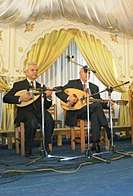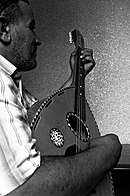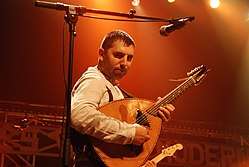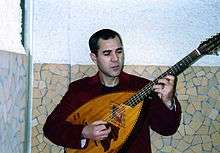Algerian mandole
|
Lounès Matoub in 1975 with an Algerian mandole. His mandole has oval and not the characteristic diamond sound hole. | |
| String instrument | |
|---|---|
| Other names | mandole, mondol |
| Classification | string |
| Hornbostel–Sachs classification |
List of musical instruments by Hornbostel-Sachs number: 321.322 (flat-backed) (Chordophone with permanently attached resonator and neck, sounded by fingers or plectrum) |
| Inventor(s) | Jean Bélido |
| Developed | 1930s in Algeria by Italian luthier in tradition of mandola and mandolin |
| Related instruments | |
|
List
| |
| More articles | |
| Music of Algeria, Music of Morocco, Chaabi music, Music of Kabyle people, Andalusian classical music, Andalusi nubah, Nuubaat | |
The Algerian mandole (mandol, mondol) is steel-string fretted instrument resembling an elongated mandolin, popular in Algerian Kabyle and Chaabi music and Nuba (Andalusian classical music).[1][2][3]
The name can cause confusion, as "mandole" is a French word for mandola, the instrument from which the Algerian mandole developed. The Algerian mandole is not however a mandola, but a mandocello sized instrument.
The instrument has also been called a "mandoluth" when describing the instrument played by the Algerian-French musician, Hakim Hamadouche.[4] However, the luthier for one of Hakim's instruments describes it as a mondole.[5]
Structure



The Algerian mandole is a stringed instrument, with an almond shaped body, built in a box like a guitar, but almond shaped like the mandola with a flat back, raised fingerboard, and wide neck (as a guitar's).[2] It can have eight, ten, or twelve strings in doubled courses, and may have additional frets between frets to provide quarter tones.[2][6] Quarter tones are used to play music with Arab and Turkish melodies.[3] A variation is to have the thickest strings be single strings instead of double courses.[7] Sound hole is typically diamond shaped, but can be round, and sometimes with rosettes.[2]
Instruments have been created with a scale length of 25.5 inches (650mm), but also as long as 27 inches.[2][3] Overall instrument length is approximately 990mm (about 39 inches).[2] Width 340mm (about 13.4 inches), depth 75mm (about 3 inches).[2]
The scale length puts the mandole in the baritone or bass range of instruments, such as the mando-cello.[2] The instrument can be tuned as a guitar, oud or mandocello, depending on the music it will be used to play and player preference. When tuning it as a guitar the strings will be tuned (E2) (E2) A2 A2 D3 D3 G3 G3 B3 B3 (E4) (E4).[8] Strings in parenthesis are dropped for a five or four course instrument. Using a common Arabic oud tuning D2 D2 G2 G2 A2 A2 D3 D3 (G3) (G3) (C4) (C4).[9] For a mandocello tuning using fifths C2 C2 G2 G2 D3 D3 A3 A3 (E4) (E4).[10]
History
The mandole was the European mandola, reborn in Algeria.[11] The North African variant was created in 1932 by the Italian luthier Jean Bélido, following recommendations made by Algerian musician El Hadj M'Hamed El Anka.[11]
El Anka, who is known for his contributions to Chaabi music, had learned to play the mandola while young.[11] He found the mandolas used in Andalusian orchestras to be "too sharp and little amplified".[12]
Bélido, a music teacher and luthier in Bab El Oued, changed the size of the "demi-mandole" then being played, increasing it, and changing the soundboard structure, case thickness and strings.[11][12] The instrument he created is closest to the mando-cello in the mandolin family.
Musicians

- Mohammed Rouane, (also spelled Rowan and Rawan by translation software) Algerian musician, former guitarist of the flamenco group Mediterraneo and pioneer of Casbah Jazz.[13][6]
- Kader Fahem, a Berber Kabylian who plays Andalusian Flamenco with his mandole.
- Abderrahmane Abdelli
- Moh Alileche, born and raised in Kabylia, performs music for 10-silk-stringed mandole - or "agember" in Tamazight language - in the San Francisco Bay Area.
- Mohamed Abdennour (also known as P'tit Moh)[13]
- El Hachemi Guerouabi[6] targets younger audience, introduces changes in his compositions that will later make him a distinctive and Master of Chaâbi
- Amar Ezzahi[6]
- Boudjemaa El Ankis[6]
- Dahmane El Harrachi
- Takfarinas[6] plays electric mandole that has two necks[13]
- Cheikh El Hasnaoui[13]
- Lounès Matoub[13][6] Kabylie, used music as political tool until killed.
- Project Coast - mandole player from Wales, UK [14] creates music on a mandole made by French luthier, François Baudemont [15]
Luthiers
- Rachid Chaffa, mandole maker for artists Guerrouabi, Amar Ezzahi, Boudjemaa El Ankis, Takfarinas and Maatoub Lounas.[16]
External links

- Video of Mohamed Rouane featuring mandole as main instrument.
- Africa, Atlas of Plucked Instruments
- Video of Hakim Hamadouche playing a mandole
- Interview: Rachid Taha. Instrument called mandolute here.
- A history of the instrument
- Short bio of El Anka with a good photo of one of his mandoles
- Mandole with F-style scroll and two necks, played by Takfarinas.
- Electric mandole, built without wood.
References
- ↑ Marie Korpe (September 2004). Shoot the singer!: music censorship today. Zed Books. pp. 114–. ISBN 978-1-84277-505-9. Retrieved 3 March 2012.
- 1 2 3 4 5 6 7 8 "mondol". atlasofpluckedinstruments.com. Retrieved 25 July 2017.
- 1 2 3 Marshall, Andy (2 February 2013). "Re: Algerian Mandole". mandolincafe.com. Retrieved 25 July 2017.
- ↑ "CARTE BLANCHE TO HAKIM HAMADOUCHE (21/01/2016) 20:30". musiquerebelle.com. Retrieved 10 August 2017.
(from concert poster): Hakim Hamadouche mandoluth, voix
- ↑ "Images tagged "jearc-hakim-hamadouche"". jearc.com. Jearc Lutherie. Retrieved 10 August 2017.
(caption with photo of instrument): Mandole HH
- 1 2 3 4 5 6 7 MnarviDZ (2014). "The Algerian Mandole". vivalalgerie.wordpress.com. Retrieved 25 July 2017.
- ↑ "Mandole/Mondole Algérien fait 100% a la main par ASSIREM en Kabylie". berberosaharan.com. Retrieved 29 July 2017.
Le mandole a 9 cordons, 4 en double et un tout seul.
- ↑ Richards, Tobe A. The Musician's Workbook VI, Fretted Instrument Octave Designation Diagram & Charts (PDF). p. 4.
Guitar - Standard Tuning E2 A2 D3 G3 B3 E4
- ↑ Parfitt, David. "Arab tuning". oud.eclipse.co.uk. Retrieved 29 July 2017.
- ↑ "Thomann Algerian Mondol 10 Standard". thomannmusic.com. Archived from the original on 2017-07-29. Retrieved 29 July 2017.
tuning: C - G - D - A - E, lower width ca. 35,2cm, body length ca. 54,2cm, total length thomann ca. 104,5cm, height incl. bridge ca. 13cm, height of the sides ca. 10cm, width upper nut ca. 4,4cm, scale length 32,4cm.
- 1 2 3 4 Bendamèche, Abdelkader (25 July 2014). "Mr Abdelkader Bendamèche répond à l'APS au sujet du mandole (Translation: Mr Abdelkader Bendamèche responds to the APS about the mandola)". abdelkaderbendameche.skyrock.com. Retrieved 25 July 2017.
ABDELKADER BENDAMECHE President of the National Council Arts and Letters, Algiers, 21 July 2014
- 1 2 "La mandole". vitaminedz.org. Retrieved 25 July 2017.
- 1 2 3 4 5 "Musique algérienne traditionnelle Chers instruments !". lesoirdalgerie.com. Le Soir d'Algérie. 9 April 2015. Retrieved 25 July 2017.
- ↑ https://www.youtube.com/user/ProjectCoast/about
- ↑ http://www.fblutherie.com
- ↑ MnarviDZ (2014). "The Algerian Mandole". vivalalgerie.wordpress.com. Retrieved 7 August 2017.
blog "Patriots on Fire"
| Wikimedia Commons has media related to Algerian mandole. |